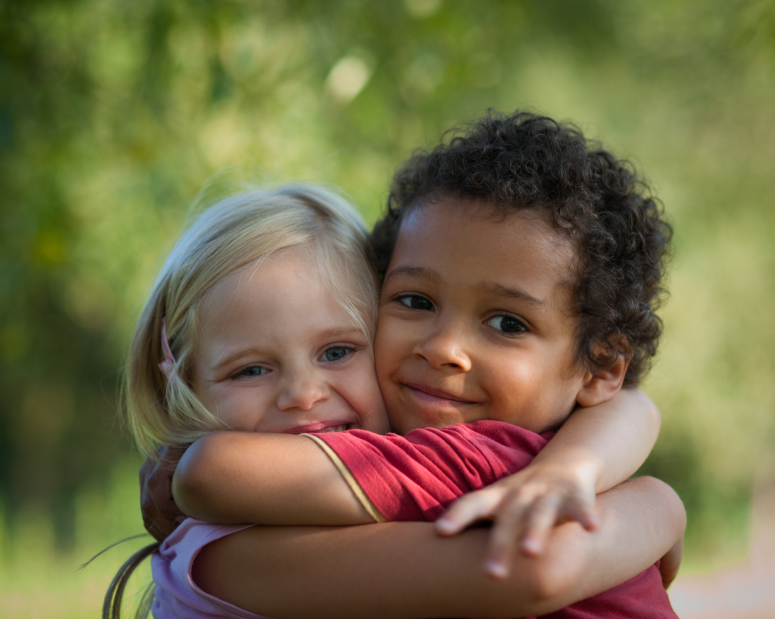Your Employee and Family Assistance Program is a support service that can help you take the first step toward change.
Helping children respect and appreciate diversity
In Canada today, families come from many different backgrounds and reflect a wide variety of cultures, languages, life experiences and lifestyles. This trend will continue into the years ahead, as diversity is a key dimension of our past, present and future.  Given this reality, children are likely to live and learn with people who may be very different from themselves.
Given this reality, children are likely to live and learn with people who may be very different from themselves.
To prepare children for life in a diverse society, and to help protect them from bias and discrimination, families and teachers can encourage children's positive feelings about themselves while also fostering understanding and acceptance of differing beliefs, values and traditions.
Principles and Strategies
Given the positive attitudes and behaviours that parents and teachers would like to promote, you can help children learn about human similarities and differences by beginning in the toddler years. Of course, words and actions in support of diversity will differ depending on children's age and stage. Yet some common principles and strategies apply throughout the early years, including:
Encouragement. In order to help children feel good about themselves, we can give them positive encouragement about who they are, what they look like and what skills they are learning. This can be done without making comparisons to others, since positive self-identity does not have to be at someone else's expense.
Embracing diversity. When discussing diversity, we can stress human similarities first, and then help children appreciate people's differences.
Providing examples. Families and teachers can provide children with lots of positive examples of human diversity. Select books, pictures, toys and games showing people of different races, ages, genders and abilities as capable and involved in all types of activities. Model, through your words and deeds, interest in a variety of people with differing beliefs, behaviours and customs.
The above suggestions discuss ways to support anti-bias learning in children. As with all other learning, repetition is important. Children will need many opportunities to explore similarities and differences, to try out new experiences from different traditions, to meet and get to know people from different backgrounds, and to ask questions—even embarrassing ones that might not have an easy answer.
Adults don't need to have all the answers ready before discussing anti-bias topics. Our own positive self-identity, our interest in and curiosity about others, and even our ignorance or misunderstandings, are all part of the journey toward honouring diversity. As children first watch and then join us on this journey, they will gain attitudes, knowledge and abilities for respecting and appreciating diversity. These are essential skills for us all—for today, tomorrow and beyond into future centuries.
 Given this reality, children are likely to live and learn with people who may be very different from themselves.
Given this reality, children are likely to live and learn with people who may be very different from themselves. To prepare children for life in a diverse society, and to help protect them from bias and discrimination, families and teachers can encourage children's positive feelings about themselves while also fostering understanding and acceptance of differing beliefs, values and traditions.
Principles and Strategies
Given the positive attitudes and behaviours that parents and teachers would like to promote, you can help children learn about human similarities and differences by beginning in the toddler years. Of course, words and actions in support of diversity will differ depending on children's age and stage. Yet some common principles and strategies apply throughout the early years, including:
Encouragement. In order to help children feel good about themselves, we can give them positive encouragement about who they are, what they look like and what skills they are learning. This can be done without making comparisons to others, since positive self-identity does not have to be at someone else's expense.
Embracing diversity. When discussing diversity, we can stress human similarities first, and then help children appreciate people's differences.
Providing examples. Families and teachers can provide children with lots of positive examples of human diversity. Select books, pictures, toys and games showing people of different races, ages, genders and abilities as capable and involved in all types of activities. Model, through your words and deeds, interest in a variety of people with differing beliefs, behaviours and customs.
The above suggestions discuss ways to support anti-bias learning in children. As with all other learning, repetition is important. Children will need many opportunities to explore similarities and differences, to try out new experiences from different traditions, to meet and get to know people from different backgrounds, and to ask questions—even embarrassing ones that might not have an easy answer.
Adults don't need to have all the answers ready before discussing anti-bias topics. Our own positive self-identity, our interest in and curiosity about others, and even our ignorance or misunderstandings, are all part of the journey toward honouring diversity. As children first watch and then join us on this journey, they will gain attitudes, knowledge and abilities for respecting and appreciating diversity. These are essential skills for us all—for today, tomorrow and beyond into future centuries.
© 2026 LifeWorks (Canada) Ltd. Your program may not include all services described on this website, please refer to your benefit material for more information. For immediate assistance, call 1.844.880.9137.
